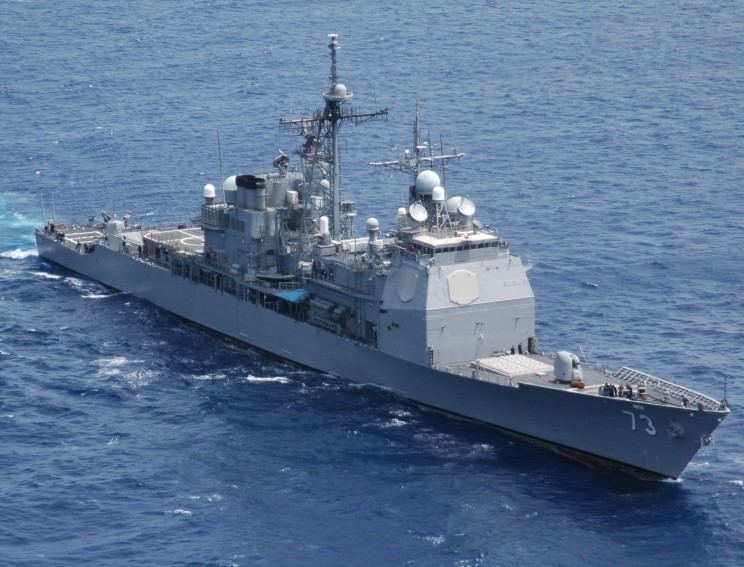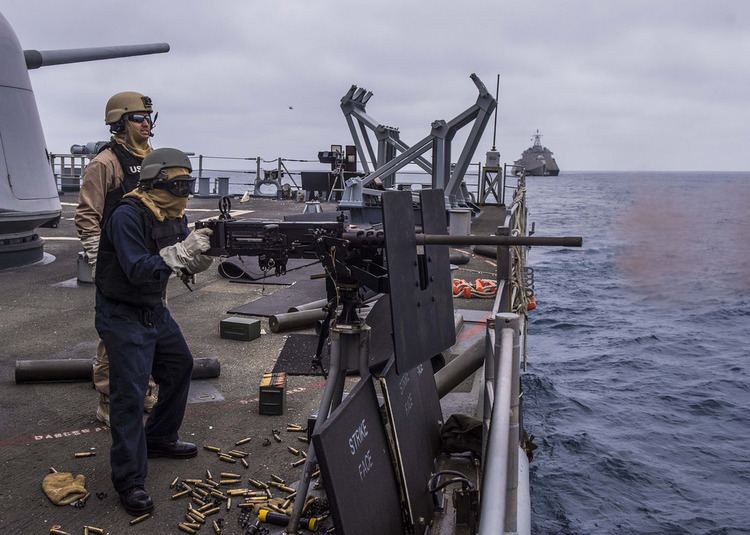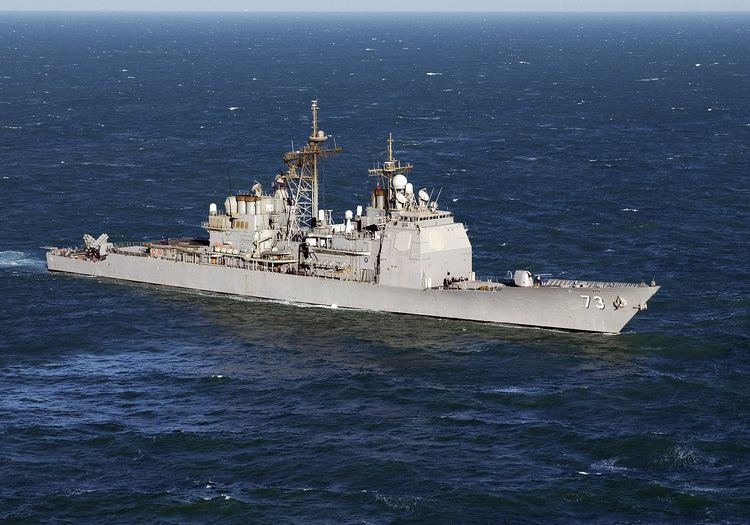Name USS Port Royal Ordered 25 February 1988 Acquired 25 April 1994 Length 173 m Launched 20 November 1992 Beam 17 m | Laid down 18 October 1991 Commissioned 9 July 1994 Construction started 18 October 1991 Draft 10 m | |
 | ||
Uss port royal cg 73
USS Port Royal (CG-73) is a United States Navy Ticonderoga-class guided missile cruiser, the 27th and final in the class. She is the second U.S. warship to bear the name of two naval battles of Port Royal Sound, South Carolina, of the American Revolutionary War and the American Civil War. However, during the initial building phase, the builders and crew were unaware of this history of the first Port Royal, as a result, the Engineering Control Center bears a plaque "First ship named".
Contents

The cruiser was ordered 25 February 1988, laid down 18 October 1991 by Ingalls Shipbuilding at Pascagoula, Mississippi, launched on 20 November 1992, christened on 5 December 1992 by Susan G. Baker (wife of James A. Baker III, Chief of Staff to President George H. W. Bush and former Secretary of State), and formally commissioned on 9 July 1994 at Savannah, Georgia; Captain Nicholas L. Richards Commanding, Lieutenant Commander Derek B. Kemp Executive Officer, and Master Chief Petty Officer Dennis W. Mills, Command Master Chief.

USS Vicksburg was originally named Port Royal but the name was formally changed during construction.
Characteristics

Port Royal and USS Lake Erie are the original cruisers for the navy's Linebacker Program (Milestone Phase I, II and III), which provided theater ballistic missile defense capability, as test platforms to detect, track, cue, intercept, and interact with other national assets to shoot down ICBMs. The vessel's Aegis and Stand Missile Tracking systems have been upgraded with "long range surveillance and track (LRS&T)", and the ships were outfitted to carry the modified SM-2 Block IVA TMD. As of 2009, USS Port Royal along with USS Lake Erie and USS Shiloh were the only three Ticonderoga-class cruisers to be equipped for the Aegis Ballistic Missile Defense Program. Port Royal participated as a tracking ship during operation "Stellar Athena" FTM 12 on 22 June 2007 off Hawaii. Port Royal's role has been taken by USS Hopper.

Originally, Port Royal was to be outfitted with the experimental shipboard mounted High Energy Laser Weapon System (HELWEPS). Based on a megawatt-class deuterium/fluorine chemical laser, HELWEPS would have replaced the standard 5-inch forward gun. HELWEPS was to have been used to destroy missiles up to about 4 kilometres (2.5 mi) away, or to burn out electro-optical sensors about 10 kilometres (6.2 mi) away. The outfitting, scheduled to occur in Naval Base Ventura County, Port Hueneme, California in 1994 was cancelled, along with all plans to install HELWEPS on Ticonderoga-class cruisers.
Four (LM2500) gas turbine engines propel Port Royal with 80,000 shaft horsepower (60,000 kW) at speeds greater than 30 knots (56 km/h; 35 mph). Two five-bladed controllable reversible pitch propellers (17-foot (5.2 m) diameter) and two rudders assist in acceleration and deceleration.
Sensors include:
Operations
Port Royal deployed from December 1995 until May 1996 as part of the Nimitz battle group Carrier Group Seven. The CVBG was participating in Operation Southern Watch, but was deployed to the South China Sea in March 1996 to act as a stabilizing force the Third Taiwan Strait Crisis. During this deployment, Captain Richards transferred command to Captain Gary Roughead on 21 January 1996. Following her first deployment, Port Royal became the first US cruiser to integrate women into the crew.
Port Royal deployed with Nimitz battle group for participation in Operation Southern Watch from September 1997 until March 1998.
Port Royal deployed with the John C. Stennis battle group, participating in Operation Southern Watch. Leaving in January 2000, she returned to Hawaii early after sustaining damage to her port shaft and Hub during pursuit of a vessel suspected of smuggling Iraqi oil in violation of U.N. sanctions. She returned in June and then in August went into drydock for repairs and upgrades.
Port Royal deployed early Pearl Harbor on 17 November 2001 to join the John C. Stennis battle group on deployment in support of Operation Enduring Freedom.
In March 2003 she was assigned to Carrier Group Seven.
Port Royal deployed with Peleliu Expeditionary Strike Group-One (ESG-1) in support of the Global War on Terrorism (GWOT) from 3 September 2003 until 11 March 2004. This was the very first deployment of an Expeditionary Strike Group.
Port Royal deployed with Peleliu Expeditionary Strike Group-Three (ESG-3) in support of the Global War on Terrorism (GWOT) from 27 February 2006 until 5 August 2006.
On 6 January 2008 the destroyer Hopper, Port Royal and the frigate Ingraham were entering the Persian Gulf through the Strait of Hormuz when five Iranian boats approached them at high speed and in a threatening manner. The U.S. ships had been in the Arabian Sea searching for a sailor who had been missing from Hopper for one day. The US Navy says the Iranian boats made "threatening" moves toward the U.S. vessels, coming as close as 200 yards (180 m). The U.S. Navy allegedly received a radio transmission saying, "I am coming at you. You will explode in a couple of minutes." As the U.S. ships prepared to fire, the Iranians abruptly turned away, the U.S. officials said. Before leaving, the Iranians dropped white boxes into the water in front of the U.S. ships. The U.S. ships did not investigate the boxes. Officials from the two nations differed on the severity of the incident. The Iranians claimed they were conducting normal maneuvers while American officials claimed that an imminent danger to American naval vessels existed.
2009 grounding
On 5 February 2009, at 9 p.m. Port Royal ran aground about a half-mile south of the Honolulu International Airport's Reef Runway. The ship had just come out of a dry dock after undergoing maintenance and was undergoing her first sea trials. No one was injured in the incident and no fuel was spilled. On 9 February 2009, Port Royal was pulled off the rock and sand shoal at around 2 a.m. No one was injured during the recovery effort. Captain John Carroll was relieved of his duties and, along with the ship's executive officer and three other sailors, subsequently disciplined for dereliction of duty and improperly hazarding a vessel. Carroll had been the commanding officer of Port Royal since 23 October 2008. Rear Admiral Dixon R. Smith, who was aboard the ship, assumed temporary command on that day, and on 9 February, Captain John Lauer III, an official in Smith's Naval Surface Group Middle Pacific, assumed command.
The warship suffered heavy damage to the underwater bow sonar dome and to her propellers and propeller shafts and was drydocked for repairs. Captain Neil Parrott was assigned to preside over the investigation into the grounding. On 18 February, the ship entered Dry Dock Number 4 at Pearl Harbor. The navy estimated that repairs would cost between $25 and $40 million. The ship left dry dock on 24 September 2009 but needed several more weeks of repair and assessment before returning to duty.
2011 deployment and beyond
After repairs were effected, the cruiser departed on an eight-month deployment to the Western Pacific and Middle East but was forced to stop in Bahrain to have structural cracks repaired. Navy command was said to have lost confidence that the vessel had been restored to seaworthiness, and, because of that, the ship was included on a list of seven cruisers slated for early retirement. Decommissioning in anticipation of eventual dismantlement was set for 31 March 2013. However, in answer to queries by Congress, the Naval Sea Systems Command (NAVSEA), in a report sent to Congress in May 2013, reported that the condition of the ship was comparable to certain other cruisers in the same class and that the effects of the grounding might not have been as severe as had been previously thought. A full report on the ship and its condition was anticipated in early August 2013. An April 2014 report by the GAO found that Port Royal was no more expensive to repair than other cruisers slated for retention.
